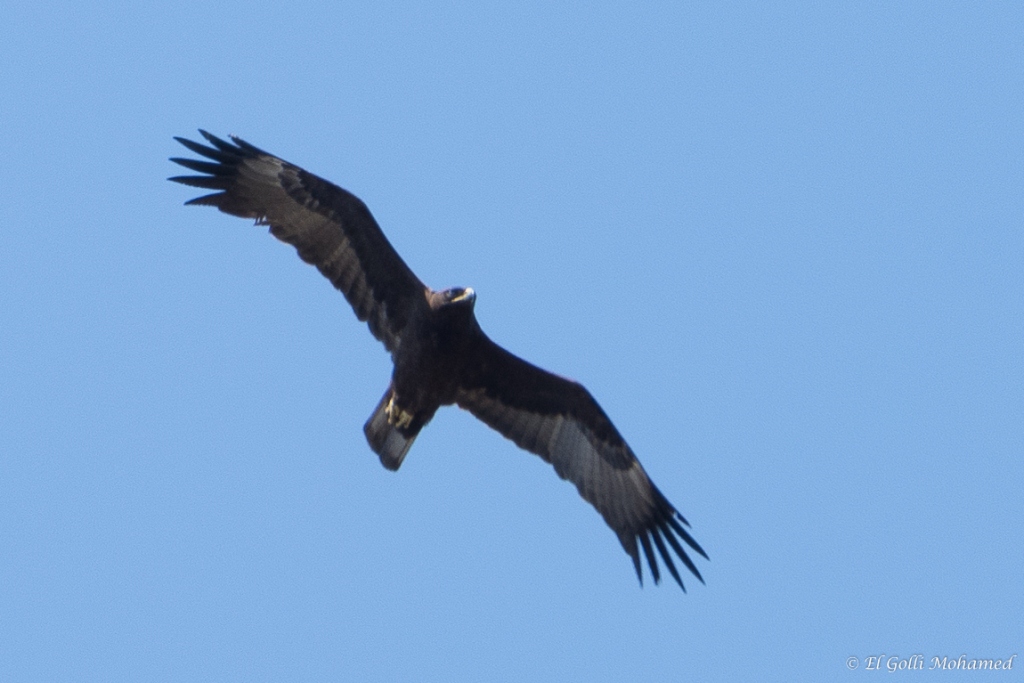An adult Wahlberg’s Eagle photographed in spring 2018 at El Haouaria, northern Tunisia. This is the first record for the country and third for the Western Palearctic.
Un Aigle de Wahlberg adulte photographié en avril 2018 à El Haouaria dans le nord de la Tunisie. Il s’agit de la première observation pour le pays et la troisième pour le Paléarctique occidental.

This is also the first adult and the northernmost record for the Western Palearctic (WP). The first for the WP was photographed at Ras Shukeir, Gulf of Suez, Egypt in May 2013 and the second was at Cap Blanc peninsula, northern Mauritania in September 2014.
Identification
The identification was not easy though, and it’s understandable. No adult of this species has ever seen this far north. In short, there was no consensus on the ID, and a few species were suggested. When Dick Forsman was contacted, here is what he said:
“To me this is no doubt an adult Wahlberg’s Eagle, definitely not Booted Eagle, nor Lesser Spotted Eagle.
The rather narrow wings with parallel edges, the relatively long “fingers” and square wing-tip, the longish and narrow tail and the long legs (with yellow toes reaching almost to the tips of the undertake coverts) are key features in a typical Wahlberg’s Eagle silhouette. The very dark and uniform body plumage nicely fits dark individuals of this species; as do the rather plain-looking remiges and rectrices, save for a wider dark subterminal band, also typical.
A Golden Eagle would probably show golden sides to neck and the shape of the wings is too rectangular and wing-tip too square, underwing pattern also not fitting any plumage of Golden.
Silhouette/structure alone differs enough to exclude both Booted Eagle and Lesser Spotted Eagle and it is easy to find several distinctive plumage features to add.
Wahlberg’s Eagle is a highly variable species with anything from nearly white to black birds, uniformly brown being the most common. The shape is diagnostic, once familiar with the species, and the underwing remiges tend to look very uniform, lacking distinct markings. Most birds, including this, show a lighter area at the base of the outer primaries, but this may be rather indistinct.
It could well be that Wahlberg’s Eagle have been overlooked in the past as it is difficult to believe that they would suddenly have become so much more common in North Africa, with several records now pending since the first was seen in Egypt only a few years ago. Where will the next one turn up?”
El Haouaria raptor watchpoint
El Haouaria, located at the tip of the natural region of Cape Bon in northeast Tunisia, is a known watchpoint for raptors and other soaring birds migrating through the Central Mediterranean flyway. For this reason, some good species turn up there as well. For example, Mohamed El Golli photographed there an Eastern Imperial Eagle in spring 2017, which was the first direct observation of the species in Tunisia. See this: ‘First record’ of Eastern Imperial Eagle for Tunisia and Northwest Africa (and see also the comments by Marton Horvath for information about a satellite-tagged bird that crossed the region earlier).

Thanks to the photographer for the excellent documentation as well as to many birders (Valéry Schollaert, Tom Conzemius, …) for the discussion. And to Dick Forsman for his extensive analysis.
Hello,
Everybody forgot to mention the main and most common identification pitfall that probably lead also the the initial misleading thoughts and some records that went unnoticed in the past. In fact, dark form really looks like a dark morph Long-legged Buzzard in MANY respects; and if you are not lucky enough to get such good photos showing the feathered tarsi and the oval nostril, they look worryingly similar in the field !!!
Hello Andrea Corso,
I think, there is no problem to distinguish this bird from dark morph Long-legged Buzzard, due to the different number of “fingers”.
Very good images and exceptional record, good job. I would be interested to upload one of the images to the First Country Reports section at the HBW-Alive. I would appreciate if you can contact the photographer to ask him permission for this.
Hi José Luis,
I will let him know.
Just saw what I thought was a Marsh Harrier here on the isle of Kerkennah, Tunisia. But very dark brown, and very large.. could it have moved south from Cap Bon in the past week?
Everything is possible, but note that the Wahlberg’s Eagle reported here was observed in April 2018.
Took any photos?